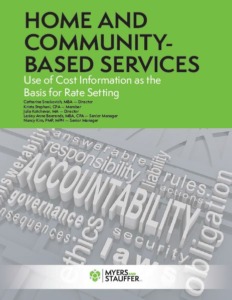In a series of posts, Myers and Stauffer will highlight home and community-based services (HCBS) and rate setting methodologies that can have a tremendous impact on services with state programs.
Provider retention in home and community-based services (HCBS) has been an issue for states in developing access for services. The pandemic and recovery concerns have exacerbated these situations. Factors such as perceived low reimbursement rates and unclear career paths for the HCBS workforce further hinder states’ efforts to recruit and retain a stable workforce to meet the service needs of their HCBS population. However, many states do not have the foundational information they need to develop a rational and sustainable approach that addresses provider needs related to their workforce challenges.
Opportunities exist for states to make foundational adjustments to better support workforce recruitment and retention by assessing how wages are considered in their current rate methodologies, and in particular, through conducting provider rate surveys. Provider rate surveys collect information about provider wages and serve as a baseline for evaluating and updating provider compensation.
Provider rate surveys also afford states the chance to review their service descriptions and ensure that the activities required from HCBS providers realistically reflect their actual job responsibilities. For example, a service description may incorporate in-service training requirements. States can use a provider rate survey to increase understanding that this is required to allow for proper reimbursement within the provider rate structure.
Provider rate surveys can also provide a mechanism for states to determine the source of workforce shortages that are not a reflection of the selected wage rate. For example, from survey data available through American Rescue Plan (ARP) Act funding, states have reported that providers are identifying a host of issues not directly related to wages that influence provider retention. Issues frequently cited include lack of paid sick leave, transportation costs, time spent on travel or non-billable services, and wage compaction that does not reward more experienced staff.
How We Can Help
The Centers for Medicare & Medicaid Services requires states to review their rates, at a minimum, every five years. Many states have leveraged ARP Act Section 9817 dollars to develop innovative strategies to assist with their HCBS workforce challenges, including the implementation of provider rate surveys. Using ARP Act funding, provider rate studies can create opportunities for states to understand their workforce needs and make necessary changes. Myers and Stauffer is currently helping clients implement rate reimbursement structures, and we have the expertise to develop provider-driven rate surveys as a tool in supporting a state’s HCBS provider workforce infrastructure.
To get additional insight into our approach to provider rate surveys, see our next blog post, coming soon. For more information, please contact us.
| Nancy Kim, MPH, Senior Manager
PH 404.524.0075 PH 866.758.3586 |



